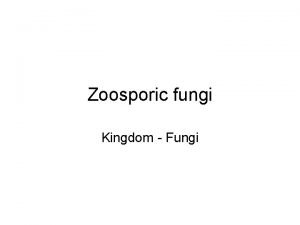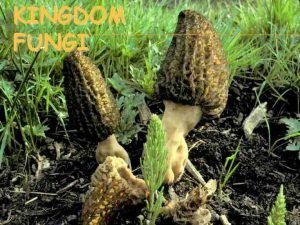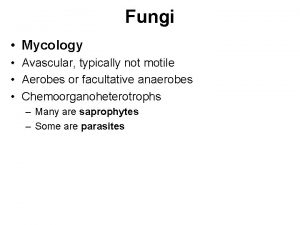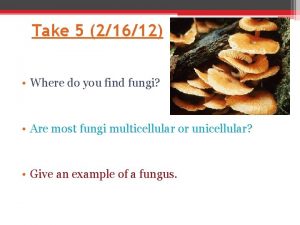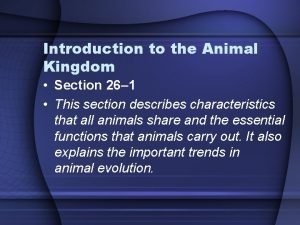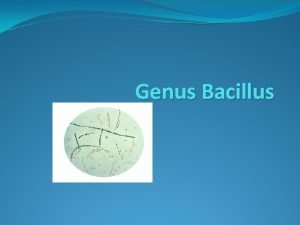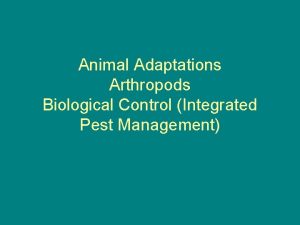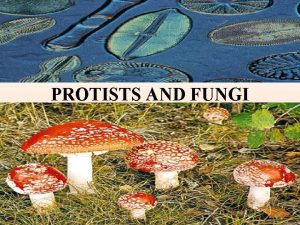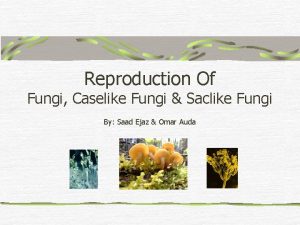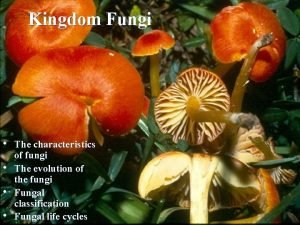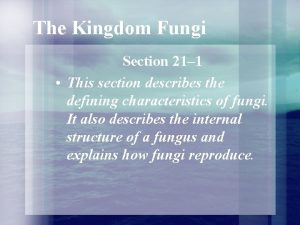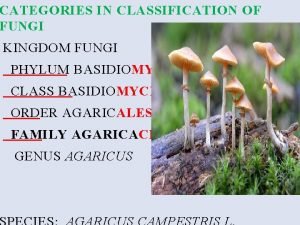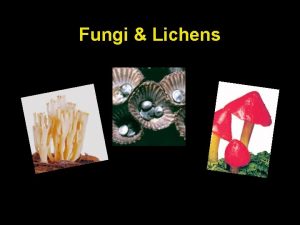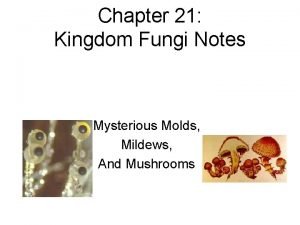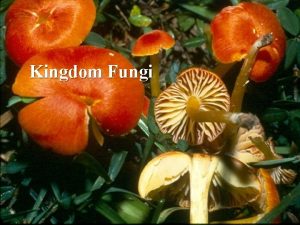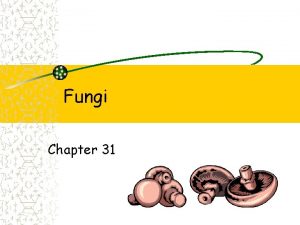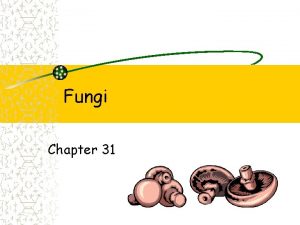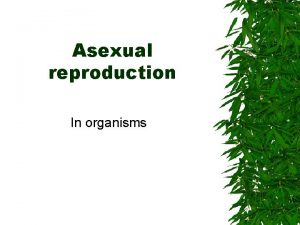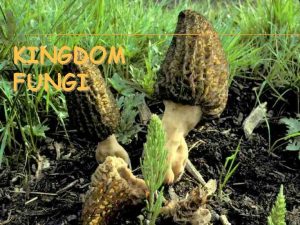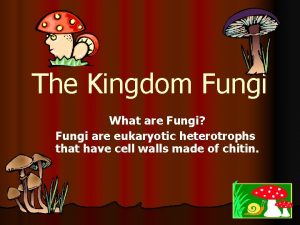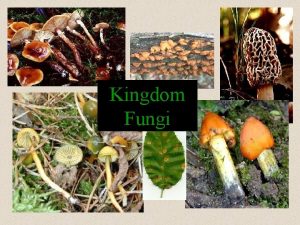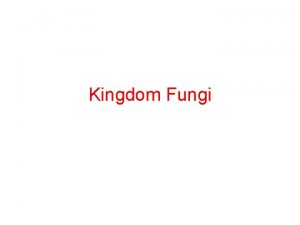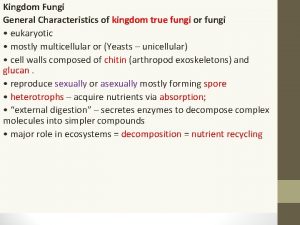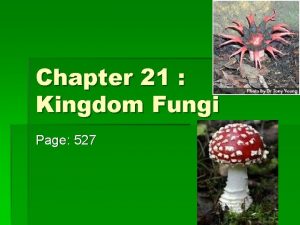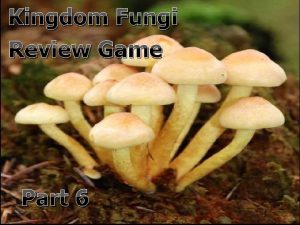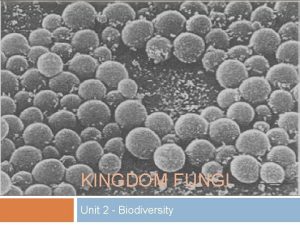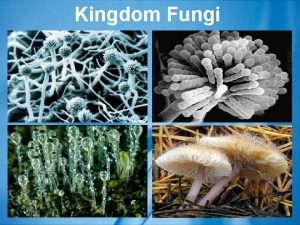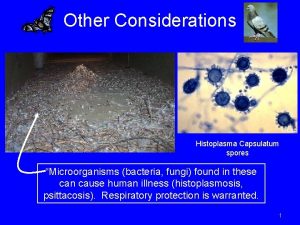Zoosporic fungi Kingdom Fungi Zoospores Motile asexual spores

































- Slides: 33

Zoosporic fungi Kingdom - Fungi

Zoospores • Motile asexual spores = zoospores • No cell wall, one flagellum • Flagella – long slender structures extending from cell and surrounded by cell membrane • 9+2 microtubular structure characteristic of eukaryotes

Zoospore • Flagellum anchored in cell with basal body

Zoosporic fungi • Asexual reproduction by zoospores produced in zoosporangia • Fungal zoospores have one posterior flagellum • Vegetative thallus variable – range from globose, multinucleate to hyphal forms • Growth may be determinate or indeterminate

Zoospores • Produced in zoosporangium • Swim away • Zoospores encyst – withdraw or lose flagellum, rapidly form a cell wall • Cyst then germinates to form rhizoids and enlarges

Zoosporic fungi • • Divided into 3 phyla Chytridiomycota (706 spp) Neocallimastigomycota (20 spp) Blastocladiomycota (179 spp)

Chytridiomycota • Habitats – zoospores require free water in which to swim – many occur in aquatic habitats, also found in soil water • Many species are saprotrophic – grow on a variety of substrates, most are aerobic, • Some are parasitic on algae, other fungi, aquatic animals, some parasitic on higher plants (crops), one is parasitic on frogs

Chytridiales – “chytrids” • Primarily aquatic • Saprotrophs grow on variety of substrates – “baiting” • Parasites of algae, fungi, animals, higher plants – • “black wart of potato” caused by Synchytrium endobioticum • Olpidium brassicae is a cabbage parasite that is a vector for a plant virus

Sexual reproduction • Great deal of variation, but nuclear events, e. g. meiosis, not clearly determined • Fusions have been seen between zoospores, gametangia, rhizoids

Vegetative thallus • Single multinucleate thallus with no appendages – If grows within host cell it is endobiotic – If entire thallus is converted to zoosporangium, it is holocarpic

Vegetative thallus • Many species form rhizoids – tapering structures that anchor thallus and increase surface area for absorption of nutrients • During differentiation, the entire thallus is not converted into a zoosporangium – eucarpic • May be within host cell – endobiotic or outside epibiotic

Vegetative thallus • Some chytrids produce only one zoosporangia per thallus – monocentric • Others produce multiple zoosporangia – polycentric • Produce rhizomycelium

Vegetative thalli

Zoosporangia • Thallus (or part) differentiates into zoosporangium • Triggered by environmental conditions, thallus size, nutrient concentration • Multinucleate cytoplasm is cleaved into a number of zoospores • Golgi produce vesicles that are deposited around nuclei – form plasma membrane, flagella • Once formed zoospores escape sporangium

Zoosporangium

Zoosporangium formation

Zoosporangium Zoospores are released from zoosporangia by • Breakdown of sporangium wall • Forming 1 or more discharge papillae Opening in papilla may be • A lid = operculum • By becoming thin and dissolving - inoperculate

Resting spores • Chytrids may form resting spores – thick cell wall, may be ornamented with spines, knobs or may be smooth • Typically undergo a period of dormancy

Batrachochytrium dendrobatidis • Parasitic on amphibians – colonizes the epithelium of adult frogs –causes a fatal inflammatory disease • responsible for decline of frog populations -

B. dendrobatidis • The disease only discovered in 1998 • Very low specificity for frog species • The chytrid also infects tadpoles – in mouthparts but does not kill them

Neocallimasticomycota • Occur in rumen and hindgut of mammalian herbivores, also in anaerobic aquatic environments • Morphologically similar to chytrids • Degrade lignocellulose, ferment glucose to acetate, lactate, ethanol & hydrogen • Are obligately anaerobic – no mitochondria, have hydrogenosomes • Monocentric or polycentric, zoospores uniflagellate or multiflagellate

Blastocladiomycota • Relatively small order – mainly saprotrophs, great variation in vegetative thallus • Characteristics – Produce brown, thick-walled pitted resting sporangia – Characteristic zoospore (nuclear cap containing cellular ribosomes) • Representative genera

Coelomomyces • Obligate parasite of aquatic animals – diploid phase on mosquito and midge larvae, haploid phase on copepods • Forms a holocarpic, endobiotic thallus • Forms isogametes that are motile for sexual reproduction • Possible biological control agents for mosquitoes (importance in understanding life cycles)

Blastocladiella • Monocentric thallus, eucarpic • Asexual life cycle – can form two types of sporangia depending on environment – Thin walled zoosporangia – Thick walled resting sporangia when CO 2 concentrations are high • Has been used to examine the biochemistry of differentiation along these two pathways

Blastocladia • Forms polycentric thallus but exhibits determinate growth

Allomyces • Great deal of research on development and genetics • Some species reproduce both sexually and asexually, in others only asexual reproduction • Some species exhibit a haploid – diploid life cycle – Haploid vegetative mycelium – Diploid vegetative mycelium

Allomyces • Haploid and diploid mycelia are identical except for the reproductive structures they produce – Haploid mycelium produces gametangia – Diploid mycelium produces zoosporangia and resistant sporangia • Hyphae branch dichotomously, produce septa with many perforations

Allomyces life cycle • Haploid zoospore germinates to form 1 n thallus • Tips of hyphae produce male and female gametangia • Male gametangia orange • Female gametangia colorless

Allomyces life cycle • Cytoplasm in gametangia cleaves to produce gametes • Both gametes are motile, leave gametangia through discharge pores in papillae

Allomyces life cycle • Gametes swim – Male gametes smaller, orange – Female gametes larger, colorless • Female gametes produce substance, sirenin that attracts male gametes chemotactically • Male and female gametes fuse (plasmogamy and karyogamy) to form zygote

Allomyces life cycle • Zygote swims and encysts • Germinates to produce diploid mycelium • Produces zoosporangia – 2 n zoospores that encyst and germinate to produce 2 n thallus

Allomyces life cycle • 2 n mycelium also produces resistant sporangia – thick walled, pitted, brown structures that can remain dormant • When resistant sporangia germinate, they undergo meiosis to form haploid zoospores that start the cycle over

Allomyces life cycle
 Monoblepharidales
Monoblepharidales Zoospores motile
Zoospores motile Characteristics of yeast
Characteristics of yeast Conidiospores
Conidiospores Characteristics of fungi kingdom
Characteristics of fungi kingdom Fungi produce _____ spores.
Fungi produce _____ spores. Old kingdom middle kingdom new kingdom
Old kingdom middle kingdom new kingdom Nnn ruled
Nnn ruled Old kingdom middle kingdom new kingdom
Old kingdom middle kingdom new kingdom Capital of egypt during the old kingdom
Capital of egypt during the old kingdom Protista mobility
Protista mobility Share
Share Fungi domain and kingdom
Fungi domain and kingdom Non motile
Non motile 26-1 introduction to the animal kingdom answer key
26-1 introduction to the animal kingdom answer key Anthracoid bacilli
Anthracoid bacilli Sessile vs motile
Sessile vs motile Protists and fungi differences
Protists and fungi differences Nonvascular plant
Nonvascular plant The spores that funguslike protists produce
The spores that funguslike protists produce Role of transpiration
Role of transpiration Clostridium spores
Clostridium spores What are spores
What are spores Nucleariids characteristics
Nucleariids characteristics The odds and ends kingdom
The odds and ends kingdom Section 21-1 the kingdom fungi answer key
Section 21-1 the kingdom fungi answer key Phylum plasmodiophoromycota
Phylum plasmodiophoromycota Domain eukarya
Domain eukarya Eukarya kingdom characteristics
Eukarya kingdom characteristics Sac fungi characteristics
Sac fungi characteristics Multicellular fungi are composed of thin filaments called
Multicellular fungi are composed of thin filaments called Is kingdom fungi unicellular or multicellular
Is kingdom fungi unicellular or multicellular Fungal cell characteristics
Fungal cell characteristics Hifa
Hifa
